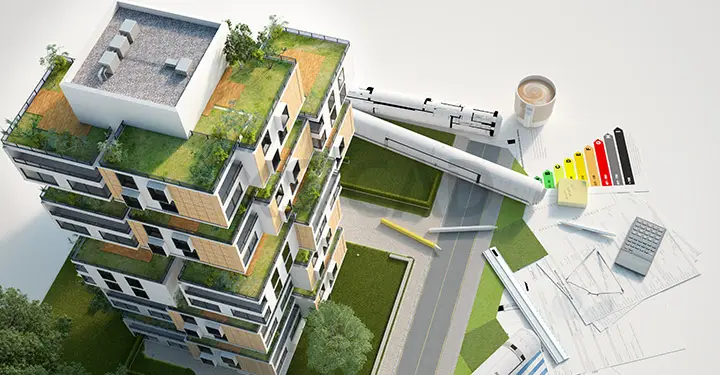Our Articles

Sustainable Homebuilding Materials & Residential BIM Modelling-Perfect Partners
When the global spotlight in construction is highlighting sustainability, can BIM (Building Information Modelling) be far behind? Using the functionality of Revit families, residential BIM modelling and other BIM modelling services can make designing sustainable homes easier, while incorporating more sustainable homebuilding materials.
Understanding Revit families and their role is important. Autodesk Revit offers libraries of Revit families, which are essentially ready-made digital objects representing architectural or MEP components and they can be customised for each project. Technically, a family is an element with common parameters which is graphically represented in Revit. Revit families for architectural planning can also be created separately and distributed to stakeholders. These kind of Revit families are called loadable families, as they can be developed as an RFA file and loaded from an external source into the project. In-place families are customised for a specific project. Host-based families consist of components that host system families, such as walls, ceilings or floors.
Architectural Revit families include:
- Staircases, railings
- Shelving
- Doors, windows
- Lighting fixtures
- Cabinets, counters, tables, chairs, beds, headboards
Structural Revit families include
- Columns, foundations
- Retaining walls, trusses
- Structural framings, structural rebars
Each Revit family will have its own reference planes, parameters, and there are formulae to create any new, complex architectural or structural family, as and when required. When a Revit family has components throughout the project with different sizes, materials and other variables, the family is said to have multiple types. When one type of family is modified, it is modified parametrically throughout the project, wherever that type occurs. For example, when the dimensions of a door type are changed, then all doors of that type are changed accordingly.
Now, to get back to sustainable homebuilding, what do we mean by sustainability in homebuilding and how can it be determined?
In a nutshell, sustainable homebuilding produces minimum impact on the environment. An environmental impact monitor can determine how a completed building can affect the environment.
Environmental Impact Monitor
How does it work?
The shadow price and carbon footprint are calculated and put in a database. The Environmental Impact Monitor links this data to the 3D BIM model in real time. The shadow price considers human toxicity, ozone depletion and acidification. The carbon footprint is influenced by the type of architectural components that are used in homebuilding.
Architectural components that exhibit good thermal performance in the building envelope, namely building insulation, can help save energy. Other factors that contribute to component sustainability include the following:
Recycled Material
Construct Recyclable Buildings
- Part of a building can be recycled, using design for disassembly
- Use fasteners that can be undone, eg. screws, not nails
- Use minimum different kinds of material
- Use large assemblies
Reused Materials
- Save natural resource
- Reduce processing
- Reduce manufacturing
- Easier to use with design for disassembly
Sustainably Harvested Material
- Harvesting resources at the same rate or slower than it can replenish, or regrow
- No net depletion of the resource, eg. sustainable forestry for wood
Rapidly Renewable Material
Local Materials
Therefore, fulfilling these parameters, sustainable building materials include:
- Sustainably harvested wood
- Flax linen
- Linoleum
- Sisal (for ropes and mats)
- Sheep wool
- Coconut
- Panels made from paper flakes
- Wood fiber plates
- Clay
- Calcium sandstone
- Vermiculite (for fire protection insulation)
- Locally stone and rock
- Paper manufactured from forest wood
- Bamboo, strong and fast-growing woody plant
- Vegetative cover or shield over building envelopes
- Recycled denim, cellulose or blown-in fiber glass insulation
Other recycled materials, especially from demolished buildings, include:
So, how does residential BIM modelling incorporate these sustainable components while designing sustainable homes?
Using BIM technology, designers are able to avail of detailed data that can ultimately help them quantify how systems and materials impact the environment. In addition, BIM technology facilitates integrated building design. Revit, as a BIM-enabled software, and Revit families play a critical role.
A 3D model is created as part of the BIM process which includes a substantial amount of detail, which designers can utilise to analyse the architectural components of the building and its form and type. The BIM model’s precise detailing and the properties of Revit families for different kinds of sustainable materials, along with building geometry data, can be a marriage made in Autodesk for sustainable homebuilding. Using BIM technology, designers can design sustainable homes more effectively.
For homebuilders looking for experienced partners to help them develop high-quality residential Revit BIM modelling, it may be advantageous to consider offshore firms. Along with years of experience and technically qualified personnel, offshore CAD/BIM companies may provide BIM modelling services, including residential BIM modelling, that can be delivered within time and budget.
XS CAD has valuable experience as a BIM modelling services provider, providing residential BIM modelling services, 3D visualisation services and residential design drawings for global firms. Our range of services for large homebuilders across the world include 2D architectural drafting, 3D BIM modelling and 3D rendering services.

